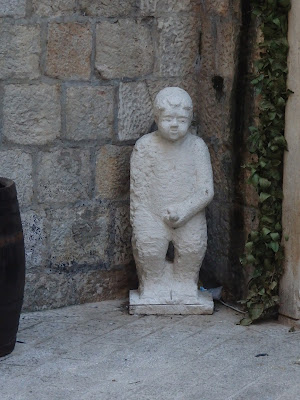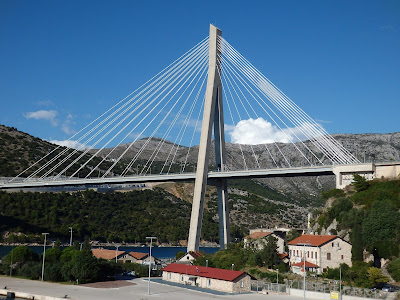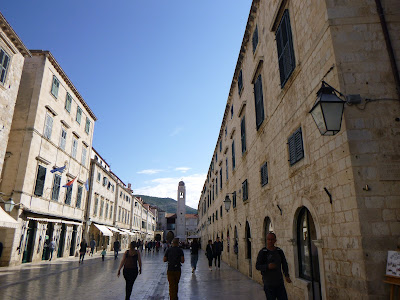 |
| From the Viking Daily. Double click to enlarge for reading |
 |
| Looking out the starboard side of the ship, we could see this bridge. |
 |
| Looking straight out the starboard side, we could see that the homes climbed the hillside but it was hard to see any access roads from the ship. |
 |
| Looking away from the gates we see the large and ornately decorated Hilton Imperial Dubrovnik. Moving our gaze to the east, we look across the street at this interesting building before continuing to turn toward the east. We see the road we came in on and some of the city walls. The city walls are the symbol of Dubrovnik. The walls were built between the 13th to the 16th century and are considered one of the most beautiful fortification systems in the world. The 1.2 miles long fortification system of Dubrovnik consists of several elements. The main city wall, over fifteen towers and forts, and three city gates – Pile Gate in the west, Ploče Gate in the east, and Buža Gate in the north. At its highest point, the wall reaches a height of 82 feet. The thickness of the wall on the land side is up to 19 feet. On the seaside, however, it is only 10 feet. This is because the sea itself was protection and Dubrovnik had a strong fleet. |
 |
| Walking beyond the sculpture we come to a viewpoint to see where the Old City Walls meet the Adrianic Sea. |
 |
| Closer view of Lovrijenac Fortress |
 |
| From the overlook we head back towards Pile Gate. This photo shows the view off the bridge. The moat is more like a park now. |
 |
| Right above the entrance, is a statue of Sveti Vlaho (St Blaise), the patron saint of Dubrovnik. Once we entered the gate, there was a set of steps going down. We took the ramp that is on the left. |
 |
| Halfway down the ramp, there were two maps. One was a map of the town and the other a map showing how this UNESCO World Heritage Site was damaged during the Yugoslavian War in 1991-1992. |
 |
| Turning our backs to the maps, we could see where we entered the City. |
 |
| We continued toward an opening in the wall to access the main city street – Stradun. But what's that in the corner? |
 |
| Is he trying to tell us something? |
 |
| There are many narrow side streets, some of which lead to stairs as they go inland. |
 |
| Looks like the summer temperatures require the city's citizens to put in air conditioners. |
 |
| The end of Stradun in the main city square. On the left if the Sponza Palace and on the right is the Bell Tower. |
 |
| Ornaments on the roof. |
 |
| Plaque on the Bell Tower |
 |
| Two thirds of the way down from the top, squares were added that digitally gives the hour in Roman numerals and the minutes in regular numbers |
 |
| Looking south from Sponza Palace. |
 |
| Statue in the middle of the market square. |
 |
| Inscription on the statue's pedestal |
 |
| As mentioned before, many scenes from the TV series Game of Thrones were filmed in Dubrovnik. Fans can take Game of Thrones tours which visit all the locations used in the show. |
 |
| Next we exited the Gate in the east |
 |
| This led us out to the marina where we could see more of the fortifications to the south and east of us. |
 |
| Looking to the left we could see the fortifications also protected the north side of the marina. We walked along the marina and back through the walls into the city. |
 |
| We turned to the left and started walking toward the stairs. |
 |
| We continued straight up the stairs but the lane veered to the right. We would take this later when we came back down the stairs. |
 |
| At the top of the stairs was the Dominican Monastery Museum. |
 |
| Entering the cloister. A cloister is a covered walk in a convent, monastery, college, or cathedral, typically with a wall on one side and a colonnade open to a quadrangle on the other. |
 |
| We entered different rooms from the cloister to view religions items. |
 |
| Early 16th century armchairs |
 |
| 11th century bible |
 |
| We exited the city at Ploče Gate. It was also featured in the Game of Thrones series as the entrance to the Red Keep. |
 |
| Once outside all the fortifications, we headed toward the cable car. We took a left and walked along the street on the outside of the walls. |
 |
| That gave us a different view of the bridge leading to Ploče Gate. |
 |
| The white crosswalk lines are where we crossed the street to continue to the cable car. |
 |
| Another look down into the moat. |
 |
| So we crossed the street and had to go up several flights of stairs to get to the lower cable car station. |
 |
| Headed up. |
 |
| I was awful disappointed when we got to the top to see that the cable car lines obstructed the view of the old town. |
 |
| We saw people walking up the hill! What a climb! |
 |
| Another cable car arriving. |
 |
| Then we found we could go out the other side of the station for a better view. |
 |
| After looking around, we headed back down. |
 |
| Walking in the moat/car park. |
 |
| As we continued walking around the outside of the walls, the street became one way. This is how we had entered the area earlier in the day. |
 |
| Yes the tour buses fit. |
 |
| Once we were further away from the walls, there was a parking lot on the left with this charging station |
 |
| Just about back to Pile Gate and the moat became a playground. |
 |
| Back to the port and on board the ship. |
 |
| Interesting house on the shore as we sailed away from Dubrovnik. |















































No comments:
Post a Comment